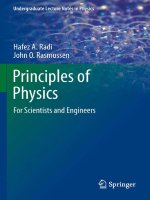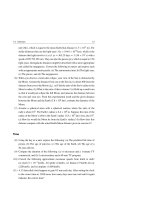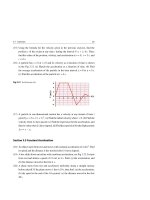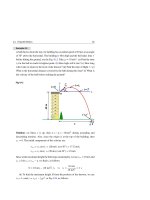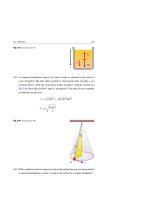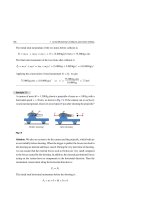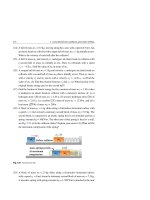Hafez a radi, john o rasmussen auth principles of physics for scientists and engineers 16
Bạn đang xem bản rút gọn của tài liệu. Xem và tải ngay bản đầy đủ của tài liệu tại đây (365.63 KB, 20 trang )
368
11 Thermal Properties of Matter
Mass of one Cu atom =
M(Cu)
63.546 kg/kmol
=
NA
6.022 × 1026 atoms/kmol
= 1.059 × 10−25 kg/atom
Example 11.5
The main constituents of air are nitrogen molecules of molar mass M(N2 ) =
28 kg/kmol and oxygen molecules of molar mass M(O2 ) = 32 kg/kmol with
approximate proportions of 80% and 20%, respectively. Using the ideal gas law,
find the mass of air in a volume of 50 cm3 at a pressure of 700 torr and temperature
of 20 ◦ C.
Solution: The molar mass of air can be obtained from the ratios of the two gases
as follows:
M(air) = 0.8 M(N2 ) + 0.2 M(O2 )
= 0.8 (28 kg/kmol) + 0.2 (32 kg/kmol) = 28.8 kg/kmol
The volume, pressure, and temperature values can be written as:
V = 50 cm3 = 5 × 10−5 m3
1.01 × 105 Pa
1 atm
×
= 9.3 × 104 Pa
760 torr
1 atm
T = 20 ◦ C = 20 + 273 = 293 K (From now on, we ignore the 0.15 K)
P = 700 torr = 700 torr ×
We can use the ideal-gas equation PV = nRT with n = m/M(air), where m is
the mass of air under consideration, to find m as follows:
m=
PVM(air)
(9.3 × 104 Pa)(5 × 10−5 m3 )(28.8 kg/kmol)
=
= 5.5 × 10−5 kg
RT
(8.314 × 103 J/kmol.K)(293 K)
Example 11.6
(a) How many molecules are there in 1 cm3 of air at room temperature (27 ◦ C)?
(b) How many kilomoles of air are in that volume? (c) The best vacuum that can
11.3 The Ideal Gas
369
be produced corresponds to a pressure of about 10−16 atm. How many molecules
remain in 1 cm3 ?
Solution: The number of molecules in 1 cm3 can be calculated from the ideal gas
equation PV = NkB T . (a) Rewriting the quantities given, we have:
V = 1 cm3 = 10−6 m3
P = 1 atm
105 Pa
T = 27 ◦ C = 27 + 273 = 300 K
Thus : N =
PV
(105 Pa)(10−6 m3 )
=
= 2.4 × 1019 molecules
kB T
(1.38 × 10−23 J/K)(300 K)
(b) We use the ideal gas equation PV = nRT to calculate the number of kilomoles as follows:
n=
PV
(105 Pa)(10−6 m3 )
=
= 4 × 10−8 kmol
RT
(8.314 × 103 J/kmol.K)(300 K)
Also, we can use the relation N = n NA to get n as follows:
n=
N
2.4 × 1019 molecules
= 4 × 10−8 kmol
=
NA
6.022 × 1026 molecules/kmol
(c) Rewriting the quantities given, we have:
V = 1 cm3 = 10−6 m3
P = 10−16 atm
10−11 Pa
T = 27 ◦ C = 27 + 273 = 300 K
Thus :
N=
(10−11 Pa)(10−6 m3 )
PV
=
= 2,415 molecules
kB T
(1.38 × 10−23 J/K)(300 K)
There are still a large number of molecules left in this 1 cm3 vacuum.
Example 11.7
A metal barrel is filled with air and is closed firmly when the pressure is 1 atm
and the temperature is 20 ◦ C. On a hot sunny day, the barrel’s temperature rises
370
11 Thermal Properties of Matter
to 60 ◦ C while its volume remains almost the same. Find the final pressure inside
the barrel.
Solution: We mark the initial state of air with P1 , V1 , T1 and final state with
P2 , V2 , T2 , see Fig. 11.7. If no air escapes from the barrel, the number of moles
of air n remains constant. Therefore, using the ideal gas law PV = nRT in the
initial and final states and the fact that V2 = V1 , we get:
T2
P1 V1
P2 V2
P1
P2
=
⇒
=
⇒ P2 = P1
T1
T2
T1
T2
T1
⎧
5
⎪
⎪
⎨ P1 = 1 atm = 1.01 × 10 Pa
The quantities given are:
T1 = 20 ◦ C = 20 + 273 = 293 K
⎪
⎪
⎩ T = 60 ◦ C = 60 + 273 = 333 K
nR =
2
Thus:
P2 = (1 atm)
333 K
= 1.14 atm = 1.15 × 105 Pa
293 K
Fig. 11.7
V2 =V1
P1
P2
Air
T1 inside
Before
V2
V1
T2
Air
inside
After
Example 11.8
The initial volume, pressure, and temperature of helium gas trapped in a container
with a movable piston are 2 × 10−3 m3 , 150 kPa, and 300 K, respectively; see
Fig. 11.8. If the volume is decreased to 1.5 × 10−3 m3 and the pressure increases
to 300 kPa find the final temperature of the gas, assuming it behaves like an ideal
gas.
Fig. 11.8
Pi ,Vi , Ti
Pf ,Vf , Tf
11.3 The Ideal Gas
371
Solution: The initial state of helium is Pi , Vi , Ti and final state is Pf , Vf , Tf .
With the use of the ideal gas law PV = nRT , we get:
Pi Vi
Pf Vf
=
Ti
Tf
⇒ Tf = Ti
Pf Vf
Pi Vi
= (300 K)
11.4
(300 kPa)(1.5 × 10−3 m3 )
= 450 K
(150 kPa)(2 × 10−3 m3 )
Exercises
Section 11.1 Temperature
(1) Convert the temperatures −30 ◦ C, 10 ◦ C, and 50 ◦ C to Kelvin and Fahrenheit.
(2) Express the normal human body temperature, 37 ◦ C, and the sun’s surface
temperature, ∼6000 ◦ C, in Fahrenheit and Kelvin.
(3) A Celsius thermometer indicates a temperature of −40 ◦ C. (a) What Fahrenheit
and Kelvin temperatures correspond to this Celsius temperature? (b) If the
temperature changes from −40 ◦ C to +10 ◦ C, find the change in temperature
on the Fahrenheit scale.
(4) The normal melting point of gold is 1064.5 ◦ C and its boiling point is 2660 ◦ C.
(a) Convert these two values to the Fahrenheit and Kelvin scales. (b) Find the
difference between those two values in Celsius. (c) Repeat (b) using the Kelvin
scale.
(5) The height of an alcohol column in an alcohol thermometer has a length 12 cm
at 0 ◦ C and a length 22 cm at 100 ◦ C. Assume that the temperature and the
length of the alcohol thermometer are linearly related. What is the temperature that the thermometer will measure if the alcohol column has a length
12.5 cm?
Section 11.2 Thermal Expansion of Solids and Liquids
(6) The Eiffel tower is built from iron and it is about 324 m high. Its coefficient
of linear expansion is approximately 12 × 10−6 (C◦ )−1 and assumed constant.
What is the increase in the tower’s length when the temperature changes from
0 ◦ C in winter to 30 ◦ C?
372
11 Thermal Properties of Matter
(7) A copper rod is 8 m long at 20 ◦ C and has a coefficient of linear expansion
α = 17 × 10−6 (C◦ )−1 . What is the increase in the rod’s length when it is heated
to 40 ◦ C?
(8) A road is built from concrete slabs, each of 10 m long when formed at 10 ◦ C,
see Fig. 11.9. How wide should the expansion cracks between the slabs be at
10 ◦ C to prevent road buckling if the range of temperature changes from −5 ◦ C
in winter to +40 ◦ C in summer? The coefficient of linear expansion for concrete
is α = 12 × 10−6 (C◦ )−1 .
Concrete
slab
Concrete
slab
10 m
10 m
Expansion crack
Fig. 11.9 See Exercise (8)
(9) An iron steam pipe is 100 m long at 0 ◦ C and has a coefficient of linear
expansion α = 10 × 10−6 (C◦ )−1 . What will be its length when heated to
100 ◦ C?
(10) An ordinary glass window has a coefficient of linear expansion α = 9 ×
10−6 (C◦ )−1 . At 20 ◦ C the sides a and b have the values 1 m and 0.8 m respectively, see Fig. 11.10. By how much does the area increase when its temperature
rises to 40 ◦ C?
Fig. 11.10 See Exercise (10)
Δa
a
b
Δa Δb
Δb
(11) A steel tape measure has a coefficient of linear expansion α = 12×10−6 (C◦ )−1
and is calibrated at 20 ◦ C. On a cold day when the temperature is −20 ◦ C, what
will be the percentage error for a reading made using this tape measure?
11.4 Exercises
373
(12) A bar of length L = 4 m and linear expansion α = 25 × 10−6 (C◦ )−1 has a crack
at its center. The ends of the bars are fixed as shown in Fig. 11.11. As a result
of a temperature rise of 40 C◦ , the bar buckles upwards, see Fig. 11.11. Find
the vertical rise d of the bar’s center.
Fig. 11.11 See Exercise (12)
T
L
T+ΔT
d
L
(13) A composite rod of length L is made from two different rods of lengths L1 and
L2 with linear expansion coefficients of α1 and α2 , respectively, see Fig. 11.12.
(a) Show that the coefficient of linear expansion α for this composite rod is
given by α = (α1 L1 + α2 L2 )/L. (b) Using the linear expansion coefficients of
steel and brass given in Table 11.2, find L1 and L2 in the case where L = 0.8 m
and α = 14 × 10−6 (C◦ )−1 .
Fig. 11.12 See Exercise (13)
L1
L2
L
(14) A homogeneous metal ring of temperature T has inner and outer radii a and b,
respectively. As the metal ring is heated to a temperature of T + T , its inner
and outer radii increase linearly to a + a and b + b respectively, see Fig.
11.13. Show that the heating has no effect on the ratio between the inner and
the outer radii.
b+Δb
Fig. 11.13 See Exercise (14)
b
a
T
a+Δa
T+ΔT
374
11 Thermal Properties of Matter
(15) A spherical brass plug has a diameter d of 10 cm at T = 150 C◦ and has a
coefficient of linear expansion α = 19 × 10−6 (C◦ )−1 , see Fig. 11.14. At what
temperature will its diameter be 9.950 cm?
Fig. 11.14 See Exercise (15)
r−|Δ r|
r
T −| Δ T |
T
(16) Two rods of the same diameter, one made of brass of length L1 = 25 cm, and the
other rod made of steel of length L2 = 50 cm, are placed end-to-end and pinned
to two rigid supports, see Fig. 11.15. The Young’s modulus for the brass and
steel rods are Y1 = 100 × 109 N/m2 and Y2 = 200 × 109 N/m2 respectively,
and their respective coefficients of linear expansion are α1 = 18 × 10−6 (C◦ )−1
and α2 = 12 × 10−6 (C◦ )−1 . The two rods are heated until the rise in temperature becomes
T = 40 C◦ . What is the stress in each rod?
Fig. 11.15 See Exercise (16)
T
L
L2
30.00 1mm
L'
27.35 mm
1
F
F
59.63 mm
T + ΔT
L'2
62.27 mm
F
F
(17) Two parallel metal bars with the same length L and negligible width, but different linear expansion coefficients α1 and α2 , are fixed at a distance d apart,
see Fig. 11.16. When their temperature changes by T , they will bend into two
circular arcs intercepting at an angle θ as shown in Fig. 11.16. Find their mean
radius of curvature r.
(18) Find the change in volume of an aluminum sphere that has a radius of 5 cm
when it is heated from 0 ◦ C to 300 ◦ C. Assume that the coefficient of volume
expansion is β = 7.2 × 10−5 (C◦ )−1 .
(19) A glass flask holds 50 cm3 at a temperature of 20 ◦ C. What is its capacity
at 30 ◦ C? Assume the coefficient of volume expansion of this glass flask is
2.7 × 10−5 (C◦ )−1 .
11.4 Exercises
375
Fig. 11.16 See Exercise (17)
d
14.82
14
.
d16
45.00 mm
L2
L1
L
2
1
2
1
r1.30
53
r
61.0
9
q
r2
69.51 mm
T + ΔT
T
(20) A flask is completely filled with mercury at 20 ◦ C and is sealed off, see
Fig. 11.17. Ignore the expansion of the glass and assume that the bulk modulus
of mercury is B = 2.5 × 109 N/m2 and its coefficient of volume expansion is
β = 1.82 × 10−4 (C◦ )−1 . Find the change in pressure inside the flask when it
is heated to 100 ◦ C.
Fig. 11.17 See Exercise (20)
Sealed flask
T=20 °C
Mercury
(21) A glass flask of volume 200 cm3 is filled with mercury when the temperature is
T = 20 ◦ C, see Fig. 11.18. The coefficient of volume expansion of the glass and
mercury are β = 1.2 × 10−5 (C◦ )−1 and β = 18 × 10−5 (C◦ )−1 respectively.
How much mercury will overflow when the temperature of the flask is raised
to 100 ◦ C?
T + ΔT
T
Mercury
Fig. 11.18 See Exercise (21) (Take 1 atm
Mercury
105 Pa unless specified)
376
11 Thermal Properties of Matter
Section 11.3 The Ideal Gas
(22) Find the density of nitrogen (N2 ) and oxygen (O2 ) at STP assuming they behave
like an ideal gas.
(23) A tank contains 0.5 m3 of nitrogen at a pressure of 1.5 × 105 N/m2 and a
temperature of 27 ◦ C. (a) What will be the pressure if the volume is increased
to 5.0 m3 and the temperature is raised to 327 ◦ C? (b) Answer part (a) if the
volume remains constant.
(24) A tank contains nitrogen N2 at an absolute pressure of 2.5 atm. What will be
the pressure of an equal mass of CO2 that replaces the nitrogen at the same
temperature?
(25) A tire is filled with air at 27 ◦ C in a normal day to a gauge pressure of 2 atm.
Then its temperature reaches 40 ◦ C in a hot day. What fraction of the original
air must be removed if the original pressure is to be restored?
(26) A 1,000 L container holds 50 kg of argon gas at 27 ◦ C. The molar mass of argon
is M = 40 kg/kmol. What is the pressure of the gas?
(27) A bubble of air rises from the bottom of a lake, where the pressure is 3 atm
and the temperature is 7 ◦ C, to the surface, where the pressure is 1 atm and
the temperature is 27 ◦ C, see Fig. 11.19. What is the ratio of the volume of the
bubble just as it reaches the surface to its volume at the bottom?
Fig. 11.19 See Exercise (27)
1 atm
27 °C
bubble
3 atm
7 °C
(28) (a) How many molecules are there in 1 L of air at a temperature of 27 ◦ C?
(b) How many kilomoles of air are in that volume? (c) The best vacuum that
can be produced corresponds to a pressure of about 10−16 atm. How many
molecules remain in 1 L?
(29) A cylindrical metallic container is filled with air and is closed firmly when the
pressure is Pi = 1 atm and the temperature is Ti = 27 ◦ C. In a very hot sunny
day, the container’s temperature rises to Tf = 70 ◦ C while its volume remains
almost the same, see Fig. 11.20. Find the final pressure inside the container.
11.4 Exercises
377
Fig. 11.20 See Exercise (29)
V2 =V1
P2
P1
V1
Air
inside
T1
Before
V2
T2
Air
inside
After
(30) The main constituents of air are nitrogen molecules of molar mass M(N2 ) =
28 kg/kmol and oxygen molecules of molar mass M(O2 ) = 32 kg/kmol with
approximate ratios of 80 and 20%, respectively. Using the ideal gas law, find
the mass of air in a volume of 1 L at atmospheric pressure and temperature
of 27 ◦ C.
(31) The initial volume, pressure, and temperature of helium gas trapped in a
container with a movable piston are Vi = 3 L, Pi = 150 kPa, and Ti = 300 K,
respectively, see Fig. 11.21. If the volume is decreased to Vf = 2.5 L and the
pressure increases to Pf = 300 kPa, find the final temperature of the gas assuming that it behaves like an ideal gas.
Fig. 11.21 See Exercise (31)
Pi ,Vi , Ti
Initial
Pf ,Vf , Tf
Final
(32) The volume of an oxygen tank is 50 L. As oxygen is withdrawn from the tank,
the pressure of the remaining gas in the tank drops from 20 atm to 8 atm,
and the temperature also drops from 30 to 10 ◦ C. (a) How many kilograms of
oxygen were originally in the tank? (b) How many kilograms of oxygen were
withdrawn from the tank? (c) What volume would be occupied by the oxygen
that withdrawn from the tank at a pressure of 1 atm and a temperature of 27 ◦ C?
(33) A balloon filled with helium is left free on the surface of the ground when
the temperature is 27 ◦ C. When the balloon reaches an altitude of 3,000 m,
where the temperature is 5 ◦ C and the pressure is 0.65 atm, how will its volume
compare to the original volume on the ground?
378
11 Thermal Properties of Matter
(34) The density of water vapor at exactly 100 ◦ C and 1 atm = 1.013 × 105 Pa is
ρ = 0.598 kg/m3 . Calculate the density of water vapor, with a molecular mass
M = 18 kg/kmol, from the ideal gas law. Why would you expect a difference?
(35) An empty room of volume V contains air having a molar mass M. At
atmospheric pressure Pa , the mass and temperature of the room are initially
mi and Ti , respectively. Assuming that the room is maintained at atmospheric
pressure while its temperature is increased to Tf , show that the final mass of
air left in the room, mf , will be given by:
mf = mi −
Pa V M
R
1
1
−
Ti
Tf
.
Heat and the First Law of Thermodynamics
12
Our focus in this chapter will be on the concept of internal energy, energy transfer,
the first law of thermodynamics, and some applications of this law. The first law of
thermodynamics expresses the general principle of conservation of energy. According to this law, an energy transfer to or from a system by either heat or work can
change the internal energy of the system.
12.1
Heat and Thermal Energy
It is important to make a major distinction between heat and internal energy (thermal
energy).
Internal energy is all the energy of a system that is associated with its microscopic constituents. Internal energy includes kinetic energy of random translational,
rotational, and vibrational motion of molecules, potential energy of molecules and
between molecules.
Heat is defined as the transfer of energy from one system to another due to a
temperature difference between them.
12.1.1 Units of Heat, The Mechanical Equivalent of Heat
Previously, heat was measured in terms of its ability to raise the temperature
of water. Thus, the calorie (cal), in cgs units, was defined as the amount of
heat required to raise the temperature of 1 g of water from 14.5 to 15.5 ◦ C. The
H. A. Radi and J. O. Rasmussen, Principles of Physics,
Undergraduate Lecture Notes in Physics, DOI: 10.1007/978-3-642-23026-4_12,
© Springer-Verlag Berlin Heidelberg 2013
379
380
12 Heat and the First Law of Thermodynamics
‘Calorie’ with a capital C, used by nutritionists, is a kilocalorie (1 Cal = 1 kcal =
103 cal).The British Thermal Unit (Btu) was also defined as the amount of heat
required to raise the temperature of 1 lb of water from 63 to 64 ◦ F. Since heat is now
known as transferred energy, the SI unit for it is the joule (J).
In a famous experiment, see Fig. 12.1, Joule measured the calorie (cal) by
converting mechanical energy into heat energy, expressed as an increase in water
temperature.
Fig. 12.1 Joule’s experiment
for measuring the mechanical
Thermometer
equivalent of heat from the
m
temperature rise in water
h Thermal
insulator
Water
Joule found that the loss in mechanical energy is proportional to the increase
in temperature of the water. The proportionality constant was found to be equal to
4,180 J/kg.C◦ . Hence, 4,180 J of mechanical energy will raise the temperature of
1 kg of water from 14.5 to 15.5 ◦ C. One kilocalorie (1 kcal) is now defined to be
exactly 4,186 J without reference to the heating of substance. Thus:
1 kcal = 4,186 J
(12.1)
The relations among the various heat units are as follows:
1 J = 2.389 × 10−4 kcal = 9.478 × 10−4 Btu
or
(12.2)
1 kcal = 4,186 J = 3.968 Btu
12.1.2 Heat Capacity and Specific Heat
The quantity of heat energy Q required to raise the temperature of an object by some
amount T varies from one substance to another.
12.1 Heat and Thermal Energy
381
The heat capacity C of an object is defined as:
The Heat Capacity C:
The heat capacity C of an object of a particular material is defined as the amount
of heat energy needed to raise the object’s temperature by one degree Celsius.
Accordingly, if Q units of heat energy are required to change the temperature by
T = Tf − Ti , where Ti and Tf are the initial and final temperatures of the object,
then:
Q=C
T , where
T = Tf − Ti
(12.3)
Heat capacity C has the unit J/C◦ (≡J/K) or kcal/C◦ (≡kcal/K).
The heat capacity for any object is proportional to its mass m. For this reason,
we define the “heat capacity per unit mass” or the specific heat c which refers to a
unit mass of the material of which the object is made. Thus, with C = m c, Eq. 12.3
becomes:
Q = m c T , where
T = Tf − Ti
(12.4)
Specific heat c has the unit:
J/kg.C◦ ≡ J/kg.K
or
kcal/kg.C◦ ≡ kcal/kg.K
The specific heat of water at 15 ◦ C and atmospheric pressure is:
cwater = 4,186 J/kg.K = 1 kcal/kg.C◦
Note that, when heat energy is added to objects, Q and T are both positive, i.e. the
temperature increases. Likewise, when heat is removed from objects, Q and T are
both negative, i.e. the temperature decreases.
In general, specific heat c varies with temperature. However, if temperature intervals are not too big, the temperature variation can be ignored, and c can be treated
as a constant. For example, the specific heat of water varies by about 1% from
0 to 100 ◦ C at atmospheric pressure. Table 12.1 presents some specific heat values
for various substances, measured at room temperature and atmospheric pressure.
382
12 Heat and the First Law of Thermodynamics
Table 12.1 Specific heat c of some substances at atmospheric pressure and room temperature (20 ◦ C)
with few exceptions
Substance
Specific heat
J/kg.C◦
kcal/kg.C◦
Silver
230
0.0564
Copper
390
0.0923
Iron or steel
450
0.107
Aluminum
900
0.215
Brass
380
0.092
Granite
790
0.19
Glass
840
0.20
Ice
(−5 ◦ C)
2,100
0.50
2,220
0.530
Mercury
140
0.033
Alcohol (Ethyl)
2,400
0.58
Seawater
3,900
0.93
Water (15 ◦ C)
4,186
1
2,010
0.48
Ice (−10 ◦ C)
Steam
(100 ◦ C)
Measuring Specific Heat
Figure 12.2 shows an example of a calorimeter, which is a device used to determine the
specific heat of a solid or liquid substance. The substance (represented by a circular
object, having a specific heat cx and mass mx ) is heated up to some known initial
temperature Tx , and then placed in a perfectly insulated vessel containing water of
specific heat cw , mass mw , and initial temperature Tw . If Tf is the final temperature
after reaching equilibrium, then Tw < Tf < Tx . Using Eq. 12.4, we calculate the heat
gained by the water to be Q = mw cw (Tf − Tw ), and calculate the heat energy lost
by the object to be −Q = mx cx (Tf − Tx ).
Assuming that the entire system does not lose or gain any heat from its surrounding, then the heat gained by the water must equal the heat lost by the object. That is:
Q = mw cw (Tf − Tw ) = −mx cx (Tf − Tx )
(12.5)
12.1 Heat and Thermal Energy
383
Solving for cx gives:
cx = cw
mw (Tf − Tw )
,
mx (Tx − Tf )
(Tw < Tf < Tx )
(12.6)
When calculating cx , we neglected heat exchange with the vessel, which is acceptable
when the mass of the water is considerably larger than that of the vessel, and when
the vessel has a negligible specific heat.
Tw
cx , mx
Thermal
insulator
Object
Tx
+
Tw
cw , mw
Tf
=
Tf
Water
Initial
Initial
Tf
Final
Fig. 12.2 In the method of mixtures, a calorimeter filled with water is used to find the specific heat of
unknown heated objects
Example 12.1
The specific heat of zinc is 352 J/kg.C◦ for temperatures near 25 ◦ C. Determine
the amount of heat required to raise the temperature of 0.5 kg zinc from 20 to
30 ◦ C. Take the specific heat to be constant in that temperature range.
Solution: The given values are c = 352 J/kg.C◦ , m = 0.5 kg, Ti = 20 ◦ C, and
Tf = 30 ◦ C. The temperature change has the following magnitude:
T = Tf − Ti = 30 ◦ C − 20 ◦ C = 10 C◦
Using Eq. 12.4 we find the amount of heat required as follows:
Q = m c T = (0.5 kg)(352 J/kg.C◦ )(10 C◦ ) = 1,760 J
384
12 Heat and the First Law of Thermodynamics
Example 12.2
A steel metal object of mass 0.05 kg is heated to 225 ◦ C and then dropped into a
vessel containing 0.55 kg of water initially at 18 ◦ C. When equilibrium is reached,
the temperature of the mixture is 20 ◦ C. Find the specific heat of the metal.
Solution: For the steel metal object, we are given mx = 0.05 kg and Tx = 225 ◦ C,
but its specific heat cx is unknown. For water, the known values are mw = 0.55 kg,
Tw = 18 ◦ C, and cw = 4,186 J/kg.C◦ (Table 12.1). For the mixture, the equilibrium
temperature occurs at Tf = 20 ◦ C. Since the heat gained by the water is equal in
magnitude to the heat lost by the steel, see Eq. 12.6 and Fig. 12.2, then we must
have:
mw cw (Tf − Tw ) = −mx cx (Tf − Tx ), (Tw < Tf < Tx )
Solving for cx we get:
mw (Tf − Tw )
mx (Tx − Tf )
(0.55 kg) (20 ◦ C − 18 ◦ C)
= (4,186 J/kg.C◦ )
(0.05 kg) (225 ◦ C − 20 ◦ C)
cx = cw
= 449 J/kg.C◦
12.1.3 Latent Heat
When heat energy is transferred from one substance to another, the temperature of
the substance often changes. However, there are situations in which the transfer of
energy does not change the temperature. Instead, the substance may change from
one form to another. Such a change is commonly referred to as a phase change or
phase transition, see Sect. 13.4 and especially Fig. 13.10.
We consider the following two main common phase changes:
1. A phase change from solid to liquid (as ice melting) and from liquid to gas
(as water boiling), where heat energy is absorbed while the temperature remains
constant.
2. A phase change from gas to liquid (as steam condensing) and from liquid to
solid (as water freezing), where heat energy is released while the temperature
remains constant.
The amount of heat energy per unit mass, L, that must be transferred when a
substance completely undergoes a phase change without changing temperature is
12.1 Heat and Thermal Energy
385
called the latent heat (literally, the “hidden” heat). If a quantity Q of heat energy
transfer is required to change the phase of a pure substance of a mass m, then
L = Q/m characterizes an important thermal property of that substance. That is:
Q = ±m L
(12.7)
A positive sign is used in this equation when energy enters the system, causing melting
or vaporization of the substance, while a negative sign corresponds to energy leaving
the system such that the substance condenses or solidifies.
When a substance experiences a phase change from solid to liquid by absorbing
heat, the heat of transformation is called the latent heat of fusion LF , see Fig. 12.3.
When the substance releases heat and experiences a phase change from liquid back
to solid, the heat of transformation is called the latent heat of solidification and is
numerically equal to the latent heat of fusion, see Fig. 12.3. In the case of water at
its normal melting or freezing temperature, we have:
LF = 3.33 × 105 J/kg = 79.5 kcal/kg = 6.01 × 106 J/kmol
(12.8)
When a substance experiences a phase change from liquid to gas by absorbing
heat, the heat of transformation is called the latent heat of vaporization LV , see
Fig. 12.3. When the gas releases heat and experiences a phase change from gas back
to liquid, the heat of transformation is called the latent heat of condensation and
is numerically equal to the latent heat of vaporization, see Fig. 12.3. For water at its
normal boiling and condensation temperatures, we have:
LV = 2.256 × 106 J/kg = 539 kcal/kg = 40.7 × 103 J/kmol
Latent heat
of fusion
LF
Latent heat of
vaporization
LV
Vaporization
Q (positive)
Fusion
Q (positive)
Solid
Gas
Liquid
Solidification
Q (negative)
(12.9)
Condensation
Q (negative)
Fig. 12.3 A sketch showing heat of fusion/vaporization (positive Q) as well as heat of condensation/
solidification (negative Q)
386
12 Heat and the First Law of Thermodynamics
Phase changes can be described in terms of a rearrangement of molecules when
heat energy is added or removed from a substance. Consider, for example, the solidto-liquid phase change. The molecules in the solid are strongly attracted to each
other. As thermal energy is absorbed, the molecules usually move further apart and
their potential energy increases. (Water-ice is an exception where there is shrinkage.)
This leads to no change in the average kinetic energy of the molecules during the
melting process, which involves molecules moving from fixed lattice positions to a
random liquid state, the temperature stays constant. The latent heat of fusion is equal
to the work done in separating the molecules during the melting process and hence
breaking their bonds and transforming the substance from the ordered solid phase
into the disordered liquid phase.
Now, we consider the liquid to gas phase change. The attractive forces between
molecules in liquid form are stronger than in gas form because the average distance
between molecules is smaller in the liquid state. As described in the solid-to-liquid
phase transition, work must be done against these attractive forces. The latent heat
of vaporization is the amount of energy added to the molecules in liquid form to
accomplish this.
Table 12.2 gives some latent heats of various substances.
Table 12.2 Latent heats of fusion and vaporization (approximates)
Substance
Melting
Melting point ◦ C
Latent heat of
fusion J/kg
Boiling
Boiling point ◦ C
Latent heat of
vaporization J/kg
Helium
−270
5.23 × 103
−269
2.09 × 104
Nitrogen
−210
2.55 × 104
−196
2.01 × 105
−219
1.38 × 104
−183
2.13 × 105
Water
0
3.33 × 105
100
2.26 × 106
Sulfur
119
3.81 × 104
445
3.26 × 105
Lead
327
2.45 × 104
1,750
8.70 × 105
Aluminum
660
3.97 × 105
2,450
1.14 × 107
Silver
961
8.82
× 104
2,193
2.33 × 106
Gold
1,063
6.44 × 104
2,660
1.58 × 106
Copper
1,083
1.34 × 105
1,187
5.06 × 106
Silicon
1,410
1.65 × 106
2,447
1.06 × 107
Oxygen
12.1 Heat and Thermal Energy
387
To understand the role of latent heat in phase changes, we calculate the energy
required to convert 1 g of ice at −50 ◦ C into steam at 150 ◦ C. Figure 12.4 shows the
results obtained when energy is added gradually to 1 g of ice. The red curve of the
figure is divided into the following five stages:
150
C
50
A 0
Ice
-50
B
Ice +
Water
0
111
Water + steam
Water
500
1000
444
863
Thermal energy (J)
Steam
T (oC)
E
D
100
3000
3123 3224
Fig. 12.4 Temperature as a function of the thermal energy added gradually to convert 1 g of ice at −50 ◦ C
into steam at 150 ◦ C
Stage A—Changing the temperature of ice from −50 to 0 ◦ C:
With a specific heat of ice ci = 2,220 J/kg.C◦ , the amount of heat added
QA is:
QA = mi ci T = (1 × 10−3 kg)(2,220 J/kg.C◦ )(50 C◦ ) = 111 J
Stage B— Ice-water mixture remains at 0 ◦ C (even heat is added):
With a latent heat of fusion LF = 3.33 × 105 J/kg, the amount of heatadded
QB until all of the ice melts is:
QB = m LF = (1 × 10−3 kg)(3.33 × 105 J/kg) = 3.33 × 102 J
Stage C— Changing the temperature of water from 0 to 100 ◦ C:
With a specific heat of water cw = 4,186 J/kg.C◦ , the amount of heat
added QC is:
QC = mw cw T = (1 × 10−3 kg)(4,186 J/kg.C◦ )(100 C◦ )
419 J
